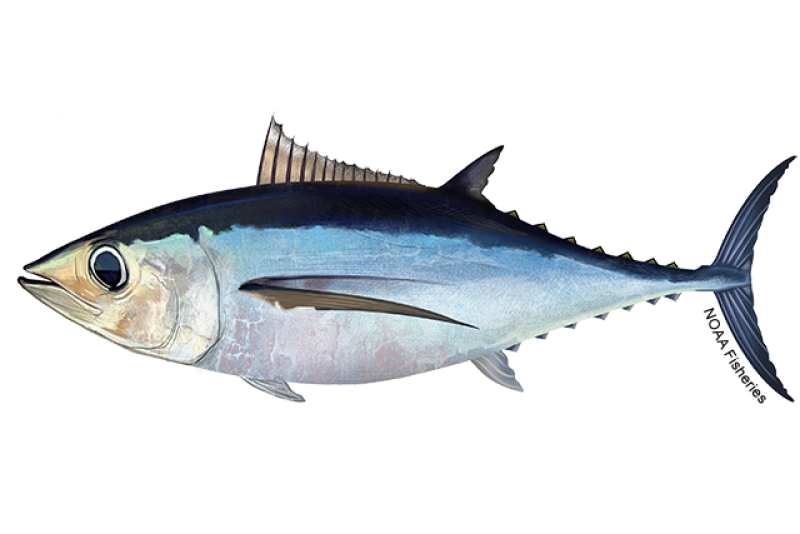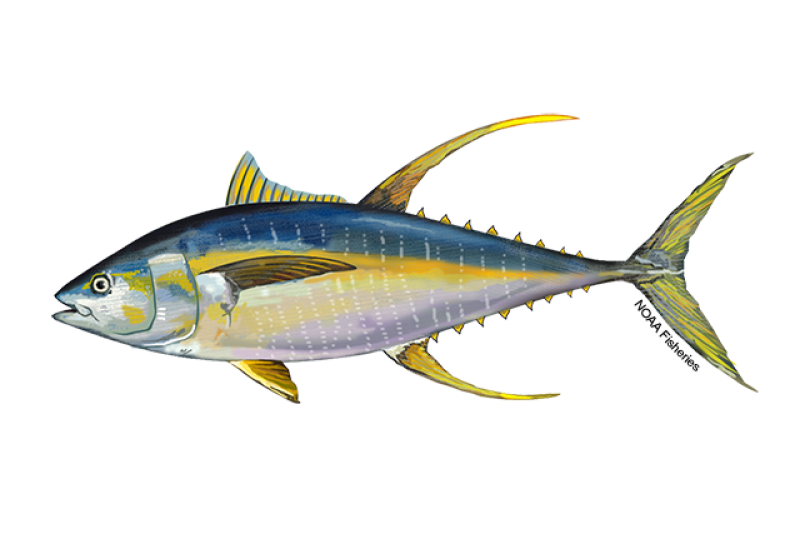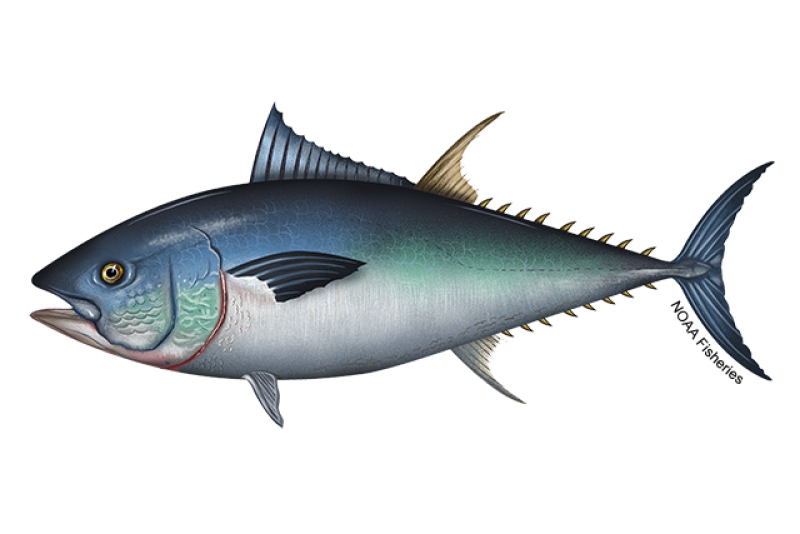About the Species
U.S. wild-caught North Atlantic albacore tuna is a smart seafood choice because it is sustainably managed and responsibly harvested under U.S. regulations.

Population
The stock is not overfished.

Fishing Rate
Not subject to overfishing.

Habitat Impact
Fishing gear used to harvest North Atlantic albacore tuna has no impact on habitat because it does not contact the ocean floor.

Bycatch
Regulations are in place to minimize bycatch.
Population Status
- According to the 2023 stock assessment, North Atlantic albacore tuna is not overfished and not subject to overfishing. Summary stock assessment information can be found on Stock SMART.
- The International Commission for the Conservation of Atlantic Tunas (ICCAT) assesses the abundance of North Atlantic albacore tuna and evaluates the sustainability of current and proposed harvest practices. They use the scientific information from these assessments to make management recommendations.
- In 2021, ICCAT adopted a comprehensive management prodedure, consistent with scientific advice, for northern albacore.
Appearance
- Albacore tuna are metallic, dark blue on the back with dusky to silvery white coloration along the sides of the belly.
- They have exceptionally long pectoral fins, which are nearly half the length of their bodies.
- The edge of the tail fin is white.
Biology
- Albacore grow relatively fast, up to more than 4 feet and 88 pounds.
- In the Atlantic, they live up to 13 years and are able to reproduce by age 5.
- In the spring and summer, albacore spawn in subtropical waters of the Atlantic and throughout the Mediterranean Sea. Depending on their size, females have between 2 million and 3 million eggs per spawning season.
- Similarly sized albacore travel together in schools that can be up to 19 miles wide. Schools of albacore also sometimes include other tuna species such as skipjack, yellowfin, and bluefin.
- Albacore constantly swim with their mouths open in order to breathe because they lack the structures needed to pump oxygen-rich water over their gills.
- They have unique biological characteristics that enable them to swim at speeds over 50 miles per hour and cover vast areas during annual migrations:
- Torpedo-shaped bodies, smooth skin, and streamlined fins
- Highly evolved circulatory system that regulates body temperature and increases muscle efficiency
- High metabolism
- High blood pressure, volume, and hemoglobin, all of which increase oxygen absorption
- Albacore tuna feed near the top of the food chain, preying upon a variety of fish, crustaceans, and squid.
- They are prey for many top predators, including sharks, rays, larger tunas, and billfish.
Where They Live
Range
- Albacore tuna live in tropical and warm temperate waters in the Atlantic, Pacific, and Indian Oceans. In the Atlantic, they’re found from Nova Scotia to northern Argentina, and from Ireland to South Africa.
Habitat
- Albacore tuna are a highly migratory species—they are found around the world and can travel long distances.
- They are a temperate (cooler water) species but spawn in warmer tropical waters.
- Juveniles prefer warmer surface waters, and adults like cooler, deeper waters.
Fishery Management
- NOAA Fisheries, through the Atlantic Highly Migratory Species Division, manage the North Atlantic albacore tuna fishery in the United States.
- Managed under the 2006 Consolidated Atlantic Highly Migratory Species Fishery Management Plan and amendments:
- Commercial and recreational fishermen must have a permit to harvest North Atlantic albacore tuna.
- Annual quota monitored
- Gear restrictions defined
- Time/area closures established
- Federal management for Atlantic tunas applies to state waters as well, except in Connecticut, and Mississippi. NOAA Fisheries periodically reviews these states’ regulations to make sure they’re consistent with federal regulations.
- Highly migratory species, such as North Atlantic albacore tuna, have complicated management that requires international cooperation.
- The United States participates in regional fisheries management organizations, such as the International Commission for the Conservation of Atlantic Tunas (ICCAT), to enhance tuna management worldwide. NOAA Fisheries sets regulations for the U.S. North Atlantic albacore tuna fishery based on our science and conservation and management measures adopted by ICCAT.
- In 2000, the United States established the Dolphin-Safe Tuna Tracking and Verification Program to monitor the domestic production and importation of all frozen and processed tuna products nationwide and to authenticate any associated dolphin-safe claim.
- An international rebuilding plan was put in place in 2010 and the stock was declared rebuilt in 2016. Since then, the stock has been managed under a conservation and management program.
Harvest
- Commercial fishery:
- U.S. fishermen catch approximately 1 percent of the total international catch of North Atlantic albacore.
- Gear types, habitat impacts, and bycatch:
- Albacore in the North Atlantic are most often harvested incidentally in the commercial pelagic longline fishery for swordfish and other tunas. U.S. commercial fishermen also use rod-and-reel gear to catch albacore tuna.
- Fishing gear used to catch albacore has no impact on habitat because it’s used in the water column and doesn’t come into contact with the ocean floor.
- Rod-and-reel gear is very selective and bycatch is minimal. U.S. commercial fishermen fishing with pelagic longline gear follow a number of strict regulations to prevent incidentally catching marine mammals, sea turtles, and birds.
- NOAA Fisheries has taken the following additional measures to prevent bycatch and sustainably manage this fishery. Pelagic longline fishermen are:
- Required to use large circle hooks and certain types of bait that limit gear interactions with sea turtles. Circle hooks are specifically designed to minimize the damage caused by hooking, giving animals that are captured and released a better chance at survival.
- Trained to use special techniques to safely dehook and release any incidentally caught turtles.
- Required to stop fishing and move 1 nautical mile if they encounter a protected species.
- Required to protect pilot whales and Risso's dolphins when fishing in the Mid-Atlantic Bight by limiting the length of their lines to 20 nautical miles and posting marine mammal handling/release guidelines on their vessels. In addition, if fishing in the Cape Hatteras Special Research Area, pelagic longliners must contact NOAA Fisheries at least 48 hours prior to a trip and carry observers if requested.
- Required to use weak hooks from January through June in the Gulf of America (formerly Gulf of Mexico) to reduce incidental catch of bluefin tuna and prohibited from using live bait to reduce bycatch of billfish.
- Restricted from areas of the Gulf of America to reduce bycatch of all species.
- Required to carry vessel monitoring systems onboard their boats to ensure compliance with these closures.
- Required to carry at-sea fisheries observers upon request. NOAA Fisheries reviews observer data to monitor protected species interactions and takes appropriate action as necessary.
- Recreational fishery:
- Recreational fishing for highly migratory species such as albacore tuna provides significant economic benefits to coastal communities through individual angler expenditures, recreational charters, tournaments, and the shoreside businesses that support those activities. Federal permits are required.
Scientific Classification
- Albacore tuna live in tropical and warm temperate waters in the Atlantic, Pacific, and Indian Oceans. In the Atlantic, they’re found from Nova Scotia to northern Argentina, and from Ireland to South Africa.
- Albacore tuna are a highly migratory species—they are found around the world and can travel long distances.
- They are a temperate (cooler water) species but spawn in warmer tropical waters.
- Juveniles prefer warmer surface waters, and adults like cooler, deeper waters.
Fishery Management
- NOAA Fisheries, through the Atlantic Highly Migratory Species Division, manage the North Atlantic albacore tuna fishery in the United States.
- Managed under the 2006 Consolidated Atlantic Highly Migratory Species Fishery Management Plan and amendments:
- Commercial and recreational fishermen must have a permit to harvest North Atlantic albacore tuna.
- Annual quota monitored
- Gear restrictions defined
- Time/area closures established
- Federal management for Atlantic tunas applies to state waters as well, except in Connecticut, and Mississippi. NOAA Fisheries periodically reviews these states’ regulations to make sure they’re consistent with federal regulations.
- Highly migratory species, such as North Atlantic albacore tuna, have complicated management that requires international cooperation.
- The United States participates in regional fisheries management organizations, such as the International Commission for the Conservation of Atlantic Tunas (ICCAT), to enhance tuna management worldwide. NOAA Fisheries sets regulations for the U.S. North Atlantic albacore tuna fishery based on our science and conservation and management measures adopted by ICCAT.
- In 2000, the United States established the Dolphin-Safe Tuna Tracking and Verification Program to monitor the domestic production and importation of all frozen and processed tuna products nationwide and to authenticate any associated dolphin-safe claim.
- An international rebuilding plan was put in place in 2010 and the stock was declared rebuilt in 2016. Since then, the stock has been managed under a conservation and management program.
Harvest
- Commercial fishery:
- U.S. fishermen catch approximately 1 percent of the total international catch of North Atlantic albacore.
- Gear types, habitat impacts, and bycatch:
- Albacore in the North Atlantic are most often harvested incidentally in the commercial pelagic longline fishery for swordfish and other tunas. U.S. commercial fishermen also use rod-and-reel gear to catch albacore tuna.
- Fishing gear used to catch albacore has no impact on habitat because it’s used in the water column and doesn’t come into contact with the ocean floor.
- Rod-and-reel gear is very selective and bycatch is minimal. U.S. commercial fishermen fishing with pelagic longline gear follow a number of strict regulations to prevent incidentally catching marine mammals, sea turtles, and birds.
- NOAA Fisheries has taken the following additional measures to prevent bycatch and sustainably manage this fishery. Pelagic longline fishermen are:
- Required to use large circle hooks and certain types of bait that limit gear interactions with sea turtles. Circle hooks are specifically designed to minimize the damage caused by hooking, giving animals that are captured and released a better chance at survival.
- Trained to use special techniques to safely dehook and release any incidentally caught turtles.
- Required to stop fishing and move 1 nautical mile if they encounter a protected species.
- Required to protect pilot whales and Risso's dolphins when fishing in the Mid-Atlantic Bight by limiting the length of their lines to 20 nautical miles and posting marine mammal handling/release guidelines on their vessels. In addition, if fishing in the Cape Hatteras Special Research Area, pelagic longliners must contact NOAA Fisheries at least 48 hours prior to a trip and carry observers if requested.
- Required to use weak hooks from January through June in the Gulf of America (formerly Gulf of Mexico) to reduce incidental catch of bluefin tuna and prohibited from using live bait to reduce bycatch of billfish.
- Restricted from areas of the Gulf of America to reduce bycatch of all species.
- Required to carry vessel monitoring systems onboard their boats to ensure compliance with these closures.
- Required to carry at-sea fisheries observers upon request. NOAA Fisheries reviews observer data to monitor protected species interactions and takes appropriate action as necessary.
- Recreational fishery:
- Recreational fishing for highly migratory species such as albacore tuna provides significant economic benefits to coastal communities through individual angler expenditures, recreational charters, tournaments, and the shoreside businesses that support those activities. Federal permits are required.
Scientific Classification
| Kingdom | Animalia | Phylum | Chordata | Class | Actinopterygii | Order | Scombriformes | Family | Scombridae | Genus | Thunnus | Species | alalunga |
|---|
Last updated by NOAA Fisheries on 04/03/2025
Featured News
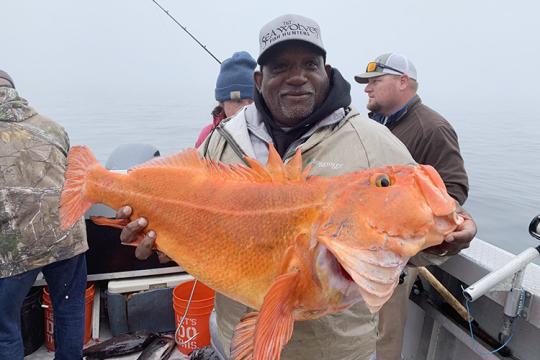
 School of yellowfin tuna. Credit: Jeff Muir
School of yellowfin tuna. Credit: Jeff Muir
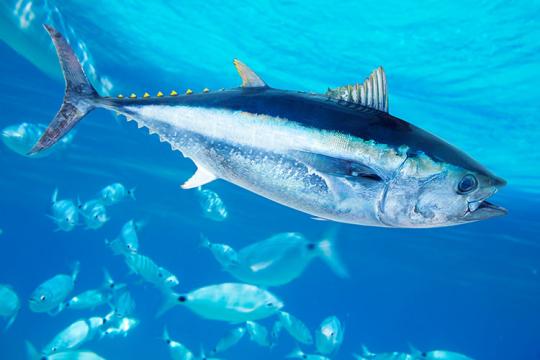

Seafood Facts

Is North Atlantic Albacore Tuna Sustainable?
U.S. wild-caught North Atlantic albacore tuna is a smart seafood choice because it is sustainably managed and responsibly harvested under U.S. regulations.
Availability
Fresh year-round, with peaks in the fall, and frozen year-round.
Source
U.S. wild-caught from Massachusetts to Louisiana.
Taste
Mild, rich taste.
Texture
Firm texture and large, moist flakes. Albacore meat is not as dense or firm as bluefin tuna, so it’s not as well-suited for sashimi.
Color
Lightest-colored meat of all the tunas – it can range from light beige to almost brown when raw, but becomes off-white when cooked. When canned, it’s the only tuna meat allowed to be labeled “white meat.”
Health Benefits
Low in fat and cholesterol with the most omega-3 fatty acids of any of the tuna species.
Nutrition Facts
Servings: 1; Serving Weight: 113 g / 4 oz (fresh); Calories: 150; Protein: 31 g ; Total Fat: 2 g; Total Saturated Fatty Acids: 1 g; Carbohydrate: 0 g; Total Sugars: 0 g; Total Dietary Fiber: 0 g; Cholesterol: 45 mg; Selenium: 36.5 mcg; Sodium: 80 mgMore Information
Albacore Tuna Recipes
Albacore tuna can be grilled or seared for a delicirous tuna steak. If you need some cooking inspiration, browse these recipes for grilled marinated tuna, seared albacore, and more!

Last updated by NOAA Fisheries on 04/03/2025
Seafood News
 Fresh-caught taʻape on ice. Credit: Conservation International Hawaiʻi.
Fresh-caught taʻape on ice. Credit: Conservation International Hawaiʻi.
Reducing Waste and Feeding Communities in Hawaiʻi with a Whole Fish Approach
 Chef Tyler Hadfield’s Curried Skate Wings with Tomato-Masala Chutney
Chef Tyler Hadfield’s Curried Skate Wings with Tomato-Masala Chutney
Ring In the New Year With These Crowd-Favorite Seafood Recipes
 NOAA Fisheries, in collaboration with Blue Ocean Mariculture, is conducting a multi-year pilot study to evaluate observational methods and tools for studying Hawaiian monk seal behavior. Courtesy of Blue Ocean Mariculture
NOAA Fisheries, in collaboration with Blue Ocean Mariculture, is conducting a multi-year pilot study to evaluate observational methods and tools for studying Hawaiian monk seal behavior. Courtesy of Blue Ocean Mariculture
AI Meets Aquaculture to Study Hawaiian Monk Seal Interactions With Net Pens
 Tonya Wick aboard a fishing vessel at sea in 1998. Photo courtesy of Tonya Wick
Tonya Wick aboard a fishing vessel at sea in 1998. Photo courtesy of Tonya Wick
Research
Top Fish Taggers for the Cooperative Tagging Center
NOAA Fisheries greatly appreciates the many tagging teams and anglers who tag and release fish to support our science.
Outreach & Education
A Guide to Tunas of the Western Atlantic Ocean
Waterproof booklet to help commercial, for-hire, and recreational fishermen and fish dealers/buyers…
Caribbean Saltwater Recreational Fisheries Snapshot
Puerto Rico and the U.S. Virgin Islands saltwater recreational fisheries fact sheet highlighting…
Last updated by NOAA Fisheries on 04/03/2025
